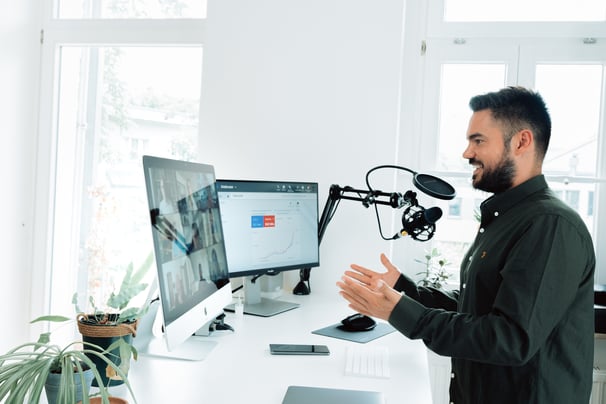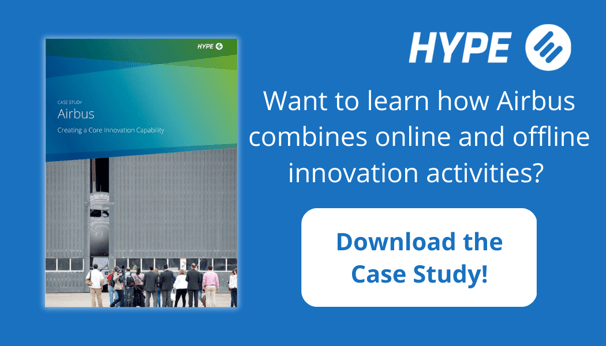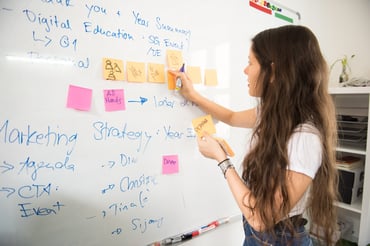Ideas can emerge anywhere: at meetings, through informal conversations, during hackathons, and, in the digital space, via emails, notes, or calls. But how do you combine online (digital) and offline (in-person) ideation and organize ideas in a single centralized space to ensure that you don’t lose any of them, no matter where they originate?
Here, we review the different approaches to idea generation, both online and offline, to help you maximize the impact of your company’s idea creation process. Let's dive in!
This blog post provides key takeaways from the webinar "How to Combine Online and Offline Ideation Most Effectively".
The idea-creation process
First, let’s define what idea creation is. In his famous book, “A Technique for Producing Ideas,” American advertising executive and author James Webb Young gave a compelling definition of the creative process:
"An idea is nothing more nor less than a new combination of old elements."
- James Webb Young
So, fundamentally, new ideas are a mixture of existing knowledge, ideas, and thoughts, “reworked” into new, sometimes better solutions.
Although ideas are often thought of as “accidental”, a sudden moment of illumination, Webb Young believes that you can provoke them by following these five steps:
- Collection: Gathering raw materials
- Immersion: Working over the material
- Incubation: Taking a rest
- Illumination: The formation of an idea
- Realization: Final shaping and development of the idea
When it comes to idea generation, certain factors can really help the creative process:
- Well-framed questions
- Access to exciting knowledge, ideas, trends
- A diverse audience of idea generators
- A relaxed atmosphere in the team
In contrast, some factors can stifle creativity:
- Lack of focus
- Lack of inspiration
- Lack of expertise
- Time pressure
Offline ideation
Most of you will have participated in face-to-face idea-generation sessions and meetings to discuss pending issues, think about solutions, and, of course, generate ideas. Most teams run these creative sessions on a regular basis without advance planning.
But, increasingly companies are organizing offline ideation workshops or hackathons to bring team members together in a creative atmosphere. Typically, these workshops include between five and 25 participants and last from two to eight hours. During this workshop, many idea-generation techniques can be used, such as brainstorming, innovation digging, and brainwriting.
Offline ideation workshops have several advantages:
- 100% dedicated time of all participants
- Possibility of generating a few ideas in a brief time
- Social interactive, and fun
But they also have some drawbacks:
- Workshops are limited in size
- Require effort to organize
- Some participants tend to dominate over others
- The results of the session are typically documented on sticky notes, whiteboards, or paper, and need to be transferred online to move the idea-generation process forward
Online ideation
Moving the creativity process online became the new norm for many firms during the COVID pandemic and, with the help of increasingly sophisticated software, online ideation is still gaining momentum.
One way to engage a large group of people in co-creating ideas is to present them with a challenge or business opportunity through an online platform.
This method of collaboration among a large audience in an idea campaign typically lasts from two to four weeks. The main difference between an online idea campaign and an offline workshop is that participants not only submit their ideas but also help enrich and review others' ideas to identify risks, roadblocks, and opportunities they notice.

The key benefits of online workshops include:
- The diversity of the audience
- The ability to generate a large number of ideas
- Simultaneous participation among idea generators
- Comfortable atmosphere
- All ideas are stored in an online archive
Online ideation also has some drawbacks:
- Less social and fun than offline ideation
- Less personal
- No specifically dedicated time set aside for idea generation
Combining offline and online ideation
To ensure the most effective collaboration and effectively manage ideas, many idea managers combine online campaigns with in-person workshops. As outlined below, holding offline events can be a valuable solution at various stages of an idea campaign.
Seeding workshop
The purpose of a seeding workshop is to distribute an online idea campaign within the idea generation team. During the workshop, the problem or business opportunity the campaign is aimed at addressing is presented. This introductory workshop is also a great time to introduce the idea-generation platform that the company will be using during the campaign.
A seeding workshop is a fantastic opportunity to pre-fill a campaign with some early ideas and comments before launching it to a wider audience. It can also be a motivating tool for team members who are hesitant to be the first to share their ideas.
The ideas collected during the seeding workshop can help to inspire other ideators to come up with valuable ideas.
Ideation workshop
Another great chance to boost your online ideation process is to conduct a regular ideation workshop to augment your online campaign. During this type of offline event, use your favorite ideation techniques and try to use as few digital tools as possible.
The main goal of the workshop is to incorporate face-to-face communication and discussion into your ideation campaign. It can be very productive for your colleagues to get away from their gadgets and discuss what’s on their minds with others.
At the end of the event, it’s important to summarize the results of the workshop and transfer them to an online platform to ensure that every valuable idea is captured. This can be done either as part of the event, with all participants, or by the innovation manager on their own.

Mid-term workshop
During the idea generation campaign, it can be effective to run an additional mid-term, face-to-face workshop. Similar to a seeding workshop, this workshop takes place in the middle of the campaign and includes a review of the ideas that have already been submitted to the online platform.
Typically, the number of participants in the mid-term workshop shouldn’t exceed 15 people who actively contribute their ideas and comment on others. It’s also worthwhile to involve colleagues who have extensive experience in the topic under discussion but who are usually hard to reach due to the volume of their daily tasks. This might also apply to the campaign sponsors, who might not be able to participate in the ideation process unless they are invited to an offline event.
The main purpose of the midterm workshop is to summarize the current ideas and, if necessary, give them a new direction. The workshop can help you understand how far your team has progressed with the topic and identify the weaknesses and strengths of the campaign. It’s also a great opportunity to accelerate a campaign that has been slow to move forward.
Concept workshop
Another common way of combining online and offline ideation is a concept workshop, which usually takes place at the end of an idea campaign when the online ideation process is completed and the results are evaluated.
The aim of a concept workshop is to select the 10 most promising ideas and build small teams around each idea: submitters, commenters, experts, and a mentor. At least half a day should be dedicated to looking at each idea from a range of different perspectives. The concept should then be presented to a “jury,” who will decide on whether to implement the idea.
This “jury” stage can be really helpful in polishing ideas and preparing them for the implementation, as it enables the concept to be assessed in more depth.
Final Thoughts
The idea creation process can be complex and time-consuming and requires significant effort from both idea managers and their colleagues. But online idea generation campaigns and offline workshops can reap large rewards. Of course, there’s no one-size-fits-all approach, so find what combination of online and offline ideation works best for you and your team!




.jpg?width=558&height=372&name=jason-goodman-vbxyFxlgpjM-unsplash%20(1).jpg)






